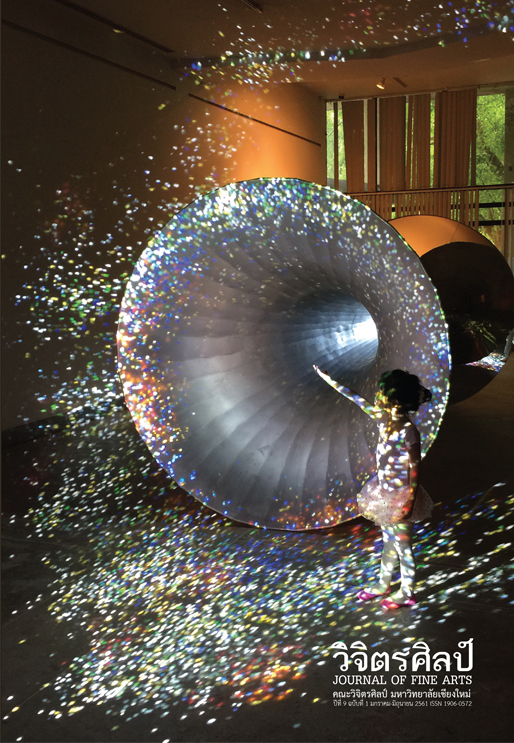การจัดการภูมิทัศน์วัฒนธรรมเพื่อการท่องเที่ยวกรณีศึกษาสถานีรถไฟลำพูน จังหวัดลำพูน
Main Article Content
Abstract
The Cultural Landscape Management for Tourism
: A Case Study of Train Station, Lamphun Province
The concept of cultural landscape is used as a tool to develop the destination image and maintain local identity. Moreover, it determines the utilization of using space to produce the positive effects for local stakeholders.
The Lamphun train station is located near Lamphun old town, in the North of Thailand. The Lamphun old town is a destination with rich cultural resources and a landscape reflecting the relationship between humans and nature. The development of the railway could enhance the travel demand according to the railway strategy plan, through the extension of the high speed train, the railway infrastructure development plan, and a surrounding area development plan.
Findings for this paper are based on documentary research, observation, survey research and interview research. The guidelines of cultural landscape management for the Lamphun train station is divided into 3 parts: 1). the conservation plan of the old Manila building style 2). The concept of the new building, based on local cultural resources 3). The improvement of the abandoned area around the Lamphun train station. These guidelines will be used to improve the tourist destination image, focusing on local cultural preservation and rehabilitation and to promote tourism in the area. It provides a way to produce a positive effect for tourism demand and economic development. Otherwise, the research also shows a process of cultural landscape tourism design in which stakeholders, alongside members from the public and private sector, which can be adapted as a guideline in other cultural landscape design projects further on.
Article Details
References
ประเทศไทย พ.ศ. 2558-2564. โครงการพัฒนาด้านคมนาคมขนส่ง
ในระยะยาว, 2557.
2. การรถไฟแห่งประเทศไทย. แผนรัฐวิสาหกิจ พ.ศ. 2555-2559. การรถไฟแห่ง
ประเทศไทย, 2554.
3. กรมการท่องเที่ยว. “สถิติรูปแบบการเดินทางมาท่องเที่ยวจังหวัดลำพูน.”
สืบค้นเมื่อวันที่ 9 ตุลาคม 2559. http://newdot2.samartmultimedia.com/home/listcontent/11/221/276.
4. ไกรฤกษ์ ปิ่นแก้ว. “เศรษฐกิจสร้างสรรค์ ทุนวัฒนธรรมและโอกาสทางธุรกิจ.”
วารสารนักบริหาร 31, 1 (2554): 32-37.
5. แขวงบำรุงทางลำพูน. แผนผัง เขตที่ดิน รฟท. แขวงบำรุงทางลำพูน, 2548.
6. เทศบาลนครลำพูน. แนวทางในการพัฒนาภูมิทัศน์วัฒนธรรมเพื่อการท่องเที่ยว
(พ.ศ. 2555). เทศบาลนครลำพูน, 2555.
7. เทียมสูรย์ สิริศรีศักดิ์ และ Natsuko Akagawa. “ความเข้าใจบางประการเกี่ยว
กับการอนุรักษ์ภูมิทัศน์วัฒนธรรมในประเทศไทย” Understanding the Concept of Cultural Landscape in Tahilan: From
Vernacular Approach to the Application of International
Framework. นิตยสารอาษา (2553): 104-112.
8. รัตนาพร เศรษฐกุล. ประวัติศาสตร์เศรษฐกิจวัฒนธรรม แอ่งเชียงใหม่-ลำพูน.
กรุงเทพฯ: สำนักงานกองทุนสนับสนุนงานวิจัย, 2552.
9. เรณู เหมือนจันทร์เชย. “ทุนวัฒนธรรมไทยทรงดำกับการเปลี่ยนผ่านยุคสมัย
ของชุมชน.” ดำรงวิชาการ วารสารรวมบทความทางวิชาการคณะ
โบราณคดี 12, 2 (2556): 175-202.
10. ฐาปนา บุณยประวิตร และ ปัทม์ ญาติมาก. “สรุปความ ความหมายและแนวคิด
ของภูมิทัศน์วัฒนธรรม.” สืบค้นเมื่อวันที่ 30 กันยายน 2559. http://
asiamuseum.co.th/paper/6.
11. วนิดา พึ่งสุนทร. แนวทางในการจัดการภูมิทัศน์วัฒนธรรม. ในความร่วมมือ
ของสำนักงานคณะกรรมการวัฒนธรรมแห่งชาติ กระทรวงวัฒนธรรม
และคณะสถาปัตยกรรมศาสตร์ มหาวิทยาลัยศิลปากร, กรุงเทพฯ:
อมรินทร์พริ้นติ้งแอนด์พับลิชชิ่ง, 2549.
12. วัชชพันธ์ บุณณลัย. สถานีรถไฟล้านนา. วิทยานิพนธ์ ศิลปมหาบัณฑิต
มหาวิทยาลัยเชียงใหม่.
13. สรรค์ เวสสุนทรเทพ และ ชัยสิทธิ์ ด่านกิตติกุล. “แนวโน้มการศึกษาภูมิทัศน์
วัฒนธรรมในประเทศไทย.” SDU Res. J. 10, 3 (2557): 143-163.
14. สุวรรณฤทธิ์ วงศ์ชะอุ่ม. “ทุนทางวัฒนธรรมเพื่อการท่องเที่ยวอย่างยั่งยืนของ
ชุมชนท่าคา อำเภออัมพวา จังหวัดสมุทรสงคราม.” วารสารวิจัยและ
พัฒนา 2 (2553): 47-59.
15. สำนักบริหารยุทธศาสตร์กลุ่มจังหวัดภาคเหนือตอนบน ๑. แผนพัฒนากลุ่ม
จังหวัดภาคเหนือตอนบน ๑ พ.ศ. 2557-2560, 2556.
16. สำนักโบราณคดีและพิพิธภัณฑสถานแห่งชาติที่ 6 เชียงใหม่. รายงานการ
สำรวจและขุดค้นทางโบราณคดี ประตูเมืองมหาวัน ตำบลในเวียง
อ.เมือง จ.ลำพูน. ลำพูน: เทศบาลเมืองลำพูน, 2544.
17. สำนักงานคณะกรรมการพัฒนาเศรษฐกิจและสังคมแห่งชาติ. ร่างแผนพัฒนา
เศรษฐกิจและสังคมแห่งชาติฉบับที่ 12 (2560-2564). เอกสาร
ประกอบการประชุมประจำปี 2559 ของ สศช. นนทบุรี. (22
กรกฎาคม 2559): 100-101.
18. สำนักงานสถิติแห่งชาติ. “สถิติการท่องเที่ยวจังหวัดลำพูน.” สืบค้นเมื่อวันที่ 9
ตุลาคม 2559. www.nso.go.th.
19. อริยา อรุณินท์. “เทศกาล งานเมือง ภูมิทัศน์วัฒนธรรมเพื่อความเป็นเมืองน่า
อยู่.” วารสารวิชาการคณะสถาปัตยกรรมศาสตร์ 49 (2548): 23-50.
20. องค์การบริหารส่วนจังหวัดลำพูน. ทะเบียนสิ่งบ่งชี้ทางภูมิศาสตร์ ผ้าไหมยก
ดอกลำพูน. ประกาศกรมทรัพย์สินทางปัญญา เรื่องการขึ้นทะเบียน
สิ่งบ่งชี้ทางภูมิศาสตร์ ผ้าไหมยกดอกลำพูน ทะเบียนเลขที่ สช
50100020. P.1-4, 2550.
21. หัทยา สิริพัฒนากุล. “ภูมิทัศน์วัฒนธรรม?.” จุลสารอิโคมอสไทย 10 (เมษายน-
กรกฎาคม), 2550.
22. Ashton Ann Suwaree. “Deveolping a Tourist Destination Brand
Value: The Stakeholders’ Perspective.” Tourism Planning
& Development. 12, 4 (2015): 398-411.
23. Buhalis Dimitrios. “Marketing the Competitive Destination of the
Future.” Tourism Management. 21 (1999): 97-116.
24. ICOMOS. Cultural landscape: Management and Conservation.
Paris: France, 2013.
25. Lee Jinsop. “Design for all 5 Senses.” Accessed January 15, 2017.
https://www.ted.com/talks/jinsop_lee_design_for_all_5_
senses?language=th.
26. Masashi Kawasaki and Shinya Matsumoto. “A Design Research of
Railway Structures and Architectures.” JSCE Civil engineering study research 06, 29 (2004): 1-4.
27. Mechtild RÖssler. “Cultural Landscape from the World Heritage
Perspectiv.” International Forum on Globally Importance
Agricultural Heritage System, Beijing, June 9-12, 2011.
28. Norbert Vanhove. The Economics of Tourism Destination. New
York: Routledge, 2012.
29. Pediaoplis, D.W.K. “The 5 Senses, University of Delaware.” Accessed
January 15, 2017. http://udel.edu/~bcarey/ART307/project1_4b.
30. Simon Wollan, Ian Woodcock. “Public Use Zone: A new paradigm
for suburban rail station design for Australian cities, State
of Australian Cities Research Network” Accessed April 26
(2017): 1-13.
31. Suttipisan, S. “Adaptive Uses of Local Textiles for Creative Tourism
Product Development in Thailand.” International Journal
of Cultural and Tourism Research. 6, 1 (2013): 47-55.
32. Taylor Ken. “The Historic Urban Landscape paradigm and cities
as cultural landscape. Challenging orthodoxy in urban
conservation.” Landscape Research 41, 4 (2016): 471-480.
33. Village Well. Train Station as Places for Community Wellbeing.
July (2006): 1-4.
34. Y.-T Peng et al. Designing “Female Prospect” into Public Space
for Taipei City. Cross-Cultural Design, 6th International Conference, CCD 2014 Held as part of SCI Conference 2014.
Heraklion, Crete, Greece, June 22-27 (2014): 311-320.


